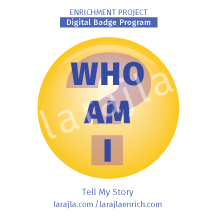 Use your life to add personal stories to your storytelling repertoire. In addition, you may find that storytelling doesn’t completely convey your story. You can add props in the form of drawings, dance, puppets or more to add another layer to your oral presentation.
Use your life to add personal stories to your storytelling repertoire. In addition, you may find that storytelling doesn’t completely convey your story. You can add props in the form of drawings, dance, puppets or more to add another layer to your oral presentation.
NOTE: To create a legacy for future generations with your stories, see the Enrichment Project “Build My Legacy” badge program.
Steps
1. Why tell a story?
Stories can be used to inform, teach, entertain or just to keep a story alive. As you look through different ways to tell your own story, decide what your story ultimately does. If it doesn’t do as you’d like, think of ways you can add / remove things from your story to reach your desired outcome. For example, if you’re looking to entertain, you may want to embellish some of the funnier parts of your story or use exaggerated movements to get a chuckle from your audience.
Family stories are often entertaining because we can relate to the stories through our own family members. List stories you’ve been told. Which would you like to retell?
2. My life.
Each person’s life is unique. Your experiences and choices have created stories only you can tell. Collect stories that you can share.
3. Journal and scrapbook.
Review journals or scrapbooks you have for additional stories you might have forgotten. Add these to your list of personal stories.
4. Other possibilities.
Explore beyond your personal life. Ask family and friends for their stories that include you. Add your own voice and experience to these stories.
Craft Your Stories
5. Humor.
Some people find it easier to tell a funny story. Some never seem to get it right. Explore ways to bring humor into your stories. Is this something you’d like to include?
6. Non-fiction.
You do not have to admit a story is based your own life / experiences. You can embellish and change it from a non-fiction story to fiction. You can add elements that give it a genre flavor. Look through your stories and brainstorm adjustments to a true story that would change it to fiction.
7. Point of view.
Why tell the story from your point of view? Use an animal or inanimate object and tell it from another point of view. You can tell the story as it happened or pull the kernel of truth / moral you want from the story and make it “audience friendly.”
8. Single or series.
Your story may be single and self-contained. You may also find upon telling it that you want to make it part of a series. If you plan to create a series, keep notes so the flow of your stories is seamless and consistent. You might also want to record your stories and transcribe them for even more detail.
Share Your Story
9. Oral.
Review the variety of ways you can tell your stories orally. Choose at least two and try them out. Do not feel limited by this list.
- Oral live presentation
- Oral recording
- StoryCorps®
- Puppet show
- Mask show
- Skits
10. Artistic.
You don’t have to tell your story with words alone. Try at least one of these to embellish your oral story.
- Art journal
- Mixed media crafts
- Animated shorts
- Photography
- Drawing / painting
- Dance / performance
11. Written.
Writing your story allows it to last longer. You will have a place to go back when you can’t remember the particulars of your story. While you’re exploring the written word, explore the possibility of using written materials as part of your oral story as well.
- Traditional publishing
- Digital publishing
- Cartoons
- Word props
- Blogging
- Scrapbooks
12. Archive.
After all this work, you don’t want to lose your stories. Find a way to archive your stories.
Supplements
SUPP_Tell My Story_2in_12up_larajla
- Avery 2.5” round label printable, 12 up
SUPP_Tell My Story_Checklist_larajla
- Badge checklist
Sites to Explore
- createyourlifestory.com
- createyourlifestory.com/podcast/difference-life-story-oral-history
- createyourlifestory.com/2010/07/storytelling-skills-technique
- www.tellingmystory.org
- www.psychologytoday.com/blog/quiet-the-power-introverts/201508/why-your-life-story-matters-and-why-you-need-tell-it-now
- www.writersdigest.com/writing-articles/by-writing-genre/memoir-by-writing-genre/7_tips_for_telling_your_life_story
- www.visuallifestories.com/your-life-story-autobiography
- www.katedudding.com
- www.storytellingarts.org/blog
Get the infographic here > larajla blog post
Get the PDFs of the badge program / supplements here > Full badge PDFs